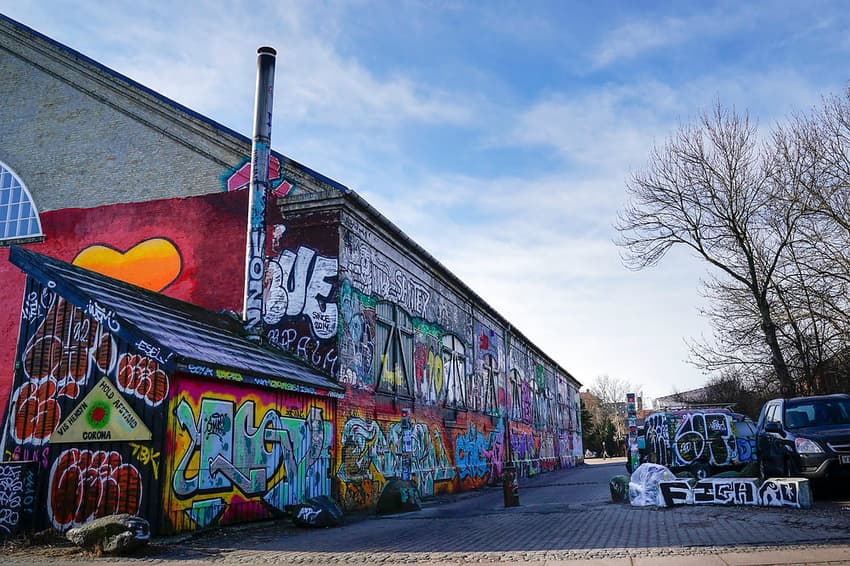Police ban on Copenhagen enclave Christiania lifted after 100 days

A ban preventing public use of parts of the Christiania area in Copenhagen has been lifted after more than 100 days and repeated extensions.
Copenhagen Police have now ended the ban on using the ‘Pusher Street’ and ‘Green Light District’ areas of Christiania, after it expired at midnight on Tuesday.
The ban, a so-called opholdsforbud, allowed the public only to pass through, but not stop in the area. It was originally introduced in January as a measure to limit the spread of Covid-19 infections. At the time, a tendency for crowds to gather in the area was cited as the basis for the measure.
It was then extended at regular intervals.
Police said on Tuesday that the ban was no longer necessary given change in national restrictions, effective as of Wednesday, which raised the outdoor assembly limit to 50 people.
Denmark enters new phase of reopening plan: Here’s what changes on Wednesday
Health authorities have also changed their recommendations in relation to social distancing in public places.
Under the now-expired ban, lingering in the affected areas was banned between 10am and midnight.
Walking, running and walking of dogs in the affected area was permitted during the periods affected by the ban, but no further public use was allowed. Failure to comply could have resulted in a fine of 2,500 kroner.
Pusher Street and the Green Light District are prominent features within Christiania, an alternative enclave in the Danish capital. In more normal times, the area is known for features including the market stands on Pusher Street, from where cannabis is sometimes illicitly traded and clamped down on by police.
Police presence in the area will remain heightened following the end of the ban, Copenhagen Police have confirmed.
“Copenhagen Police will still have increased presence in the area to ensure the relevant Covid-19 restrictions are complied with,” the police said in a statement on Tuesday.
“If that is not the case, police can re-establish a ban in the area,” the statement also said.
Asked in March by broadcaster DR whether the ban, the only one of its type in the country, is partly motivated by Christiania’s connection to cannabis dealing, senior Copenhagen Police officer Tommy Laursen dismissed the connection.
“No. We are currently using considerably more staff in the area than we did before the ban was introduced,” Laursen said.
Residents in Christiania decided in January to close off the entrance to the neighbourhood with a fence due to concerns the cannabis trade, which is usually conducted in the areas affected by the ban, would spread to nearby areas.
In March, police arrested and charged 25 people in Christiania for organised cannabis dealing. An information stand set up in the area following the ban was also used to deal cannabis, police said in March.
Comments (1)
See Also
Copenhagen Police have now ended the ban on using the ‘Pusher Street’ and ‘Green Light District’ areas of Christiania, after it expired at midnight on Tuesday.
The ban, a so-called opholdsforbud, allowed the public only to pass through, but not stop in the area. It was originally introduced in January as a measure to limit the spread of Covid-19 infections. At the time, a tendency for crowds to gather in the area was cited as the basis for the measure.
It was then extended at regular intervals.
Police said on Tuesday that the ban was no longer necessary given change in national restrictions, effective as of Wednesday, which raised the outdoor assembly limit to 50 people.
Denmark enters new phase of reopening plan: Here’s what changes on Wednesday
Health authorities have also changed their recommendations in relation to social distancing in public places.
Under the now-expired ban, lingering in the affected areas was banned between 10am and midnight.
Walking, running and walking of dogs in the affected area was permitted during the periods affected by the ban, but no further public use was allowed. Failure to comply could have resulted in a fine of 2,500 kroner.
Pusher Street and the Green Light District are prominent features within Christiania, an alternative enclave in the Danish capital. In more normal times, the area is known for features including the market stands on Pusher Street, from where cannabis is sometimes illicitly traded and clamped down on by police.
Police presence in the area will remain heightened following the end of the ban, Copenhagen Police have confirmed.
“Copenhagen Police will still have increased presence in the area to ensure the relevant Covid-19 restrictions are complied with,” the police said in a statement on Tuesday.
“If that is not the case, police can re-establish a ban in the area,” the statement also said.
Asked in March by broadcaster DR whether the ban, the only one of its type in the country, is partly motivated by Christiania’s connection to cannabis dealing, senior Copenhagen Police officer Tommy Laursen dismissed the connection.
“No. We are currently using considerably more staff in the area than we did before the ban was introduced,” Laursen said.
Residents in Christiania decided in January to close off the entrance to the neighbourhood with a fence due to concerns the cannabis trade, which is usually conducted in the areas affected by the ban, would spread to nearby areas.
In March, police arrested and charged 25 people in Christiania for organised cannabis dealing. An information stand set up in the area following the ban was also used to deal cannabis, police said in March.
Join the conversation in our comments section below. Share your own views and experience and if you have a question or suggestion for our journalists then email us at [email protected].
Please keep comments civil, constructive and on topic – and make sure to read our terms of use before getting involved.
Please log in here to leave a comment.